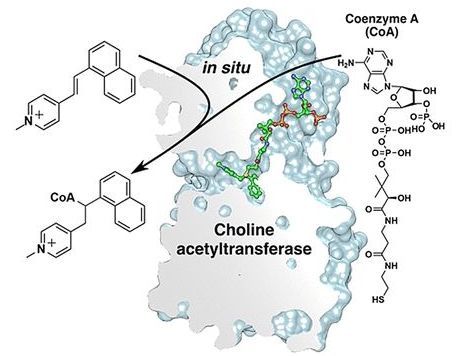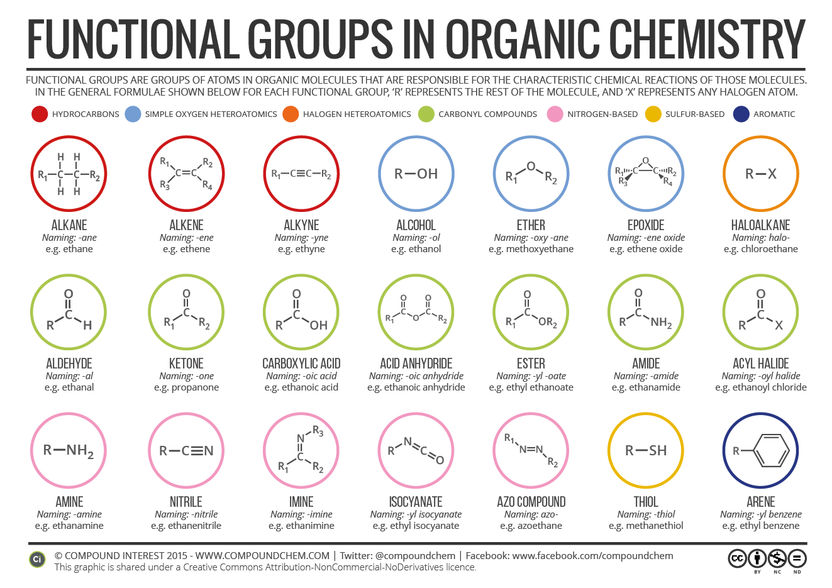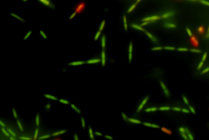Inhibitor in a Tunnel
New method for the development of choline acetyltransferase inhibitors
The enzyme choline acetyltransferase (ChAT) catalyzes the synthesis of the neurotransmitter acetylcholine and could be a target molecule for pharmaceuticals. A Swedish research team has now determined the mechanism by which arylvinylpyridinium (AVP), a known class of ChAT inhibitors, functions. As they report in the journal Angewandte Chemie, ChAT manufactures the actual agent itself by attaching coenzyme A (CoA) to AVP.

© Wiley-VCH
Acetylcholine passes on nerve impulses in synapses, among other things. Changes in the amount or activity of ChAT, which produces acetylcholine from choline and acetylcoenzyme A (AcCoA), have been observed in a variety of diseases, such as Alzheimer’s disease, schizophrenia, congenital disruption of signal conduction between nerves and muscles, and chronic viral infections. In addition, inhibition of ChAT could serve as an effective treatment for poisoning by organophosphate neurotoxins.
To date, suitable ChAT inhibitors have been unavailable. Arylvinylpyridinium compounds (AVPs) were good inhibitors in vitro, but their pharmacological profile proved to be inconsistent. A team at the Swedish Defense Research Agency and Umeå University (Sweden) led by Fredrik Ekström has now been able to clarify the inhibition mechanism of AVPs and provide insights that could be used as the basis for developing ChAT inhibitors with better effectiveness and bioactivity.
The researchers were able to demonstrate that the actual bioactive agents are not the AVPs themselves, but the adduct they form with CoA. Connection of these two components is carried out by ChAT itself. The enzyme builds its own inhibitor starting from an exogenic precursor (AVP) and an endogenic co-substrate (CoA). The reaction is an unusual hydrothiolation, which forms a bond between the thiol group of the CoA and the vinyl group of the AVP.
The binding and catalytic domains in ChAT form a narrow “tunnel” that passes across the enzyme. X-ray crystallographic studies of human ChAT in the presence of CoA and AVP showed that the inhibiting adduct is embedded deep within this tunnel. Interactions with hydrophobic pockets near the choline binding site have significant effects on the strength of ChAT inhibitors.
The researchers hope that their discoveries will allow for the development of novel ChAT inhibitors with improved strength and duration of activity.
Original publication
Other news from the department science

Get the life science industry in your inbox
By submitting this form you agree that LUMITOS AG will send you the newsletter(s) selected above by email. Your data will not be passed on to third parties. Your data will be stored and processed in accordance with our data protection regulations. LUMITOS may contact you by email for the purpose of advertising or market and opinion surveys. You can revoke your consent at any time without giving reasons to LUMITOS AG, Ernst-Augustin-Str. 2, 12489 Berlin, Germany or by e-mail at revoke@lumitos.com with effect for the future. In addition, each email contains a link to unsubscribe from the corresponding newsletter.
Most read news
More news from our other portals
Last viewed contents
Gene switch important in cancer discovered

Functional Groups in Organic Compounds
New particle can track chemo
"Combination" Lyme Disease Vaccine Proteins Patented
GVK Biosciences opens new Clinical Pharmacology Unit in Ahmedabad - New facility commissioned to meet increasing business demand

Long Antibiotic Treatments: Slowly Growing Bacteria to Blame

Nanocrystals that eradicate bacteria biofilm - Research team finds ways to control the surface texture of nanostructures


















































